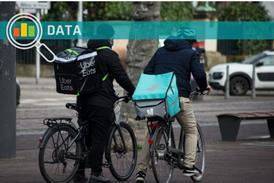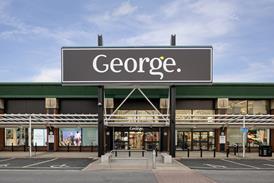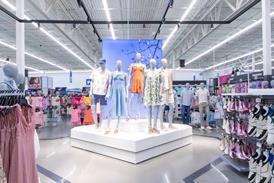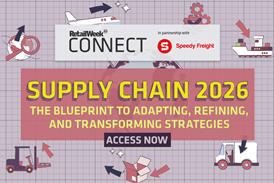
From collaborating on designs to elevating the customer experience, artificial intelligence is changing fashion retail forever
After decades of development and years of hype, it feels fairly obvious to state that artificial intelligence is likely to transform the way fashion retail operates.
But while it’s true that AI is already embedded in many fashion retailers’ businesses, the exact details of how it will continue to transform the sector are yet to come into focus – especially when it comes to generative AI.
Retail Week launched its monthly Fashion Forward: Forecasting the sector’s future design content series in partnership with Bloomreach in July, with analysis revealing the top 30 fashion retailers by 2026/27 based on predicted sales. In this fourth analysis, Retail Week explores how AI will change the way fashion retail operates.
“AI is already transforming retail in many ways,” says Retail Week research director Lisa Byfield-Green. “Data and AI are already invaluable to retailers in areas including demand forecasting, supply chain visibility and operational efficiency.” She adds that AI is being used in “customer engagement, merchandising and planning, smart stores, digital commerce, advanced data insights and intelligent supply chain”.
Fashion assistants
What is newer, however, is generative AI, which burst into most people’s consciousness in November 2022 when ChatGPT was launched. What this will mean for fashion retail is still developing but, as Byfield-Green says, the first iteration is likely to be better real-time recommendations for customers looking for something specific.
German retailer Zalando is one of those leading the way: in April 2023, it announced the launch of a fashion assistant powered by ChatGPT across its web and app platforms. The service helps users navigate its selection without endless scrolling, and the company says it is gradually rolling it out, with UK customers already able to use it.
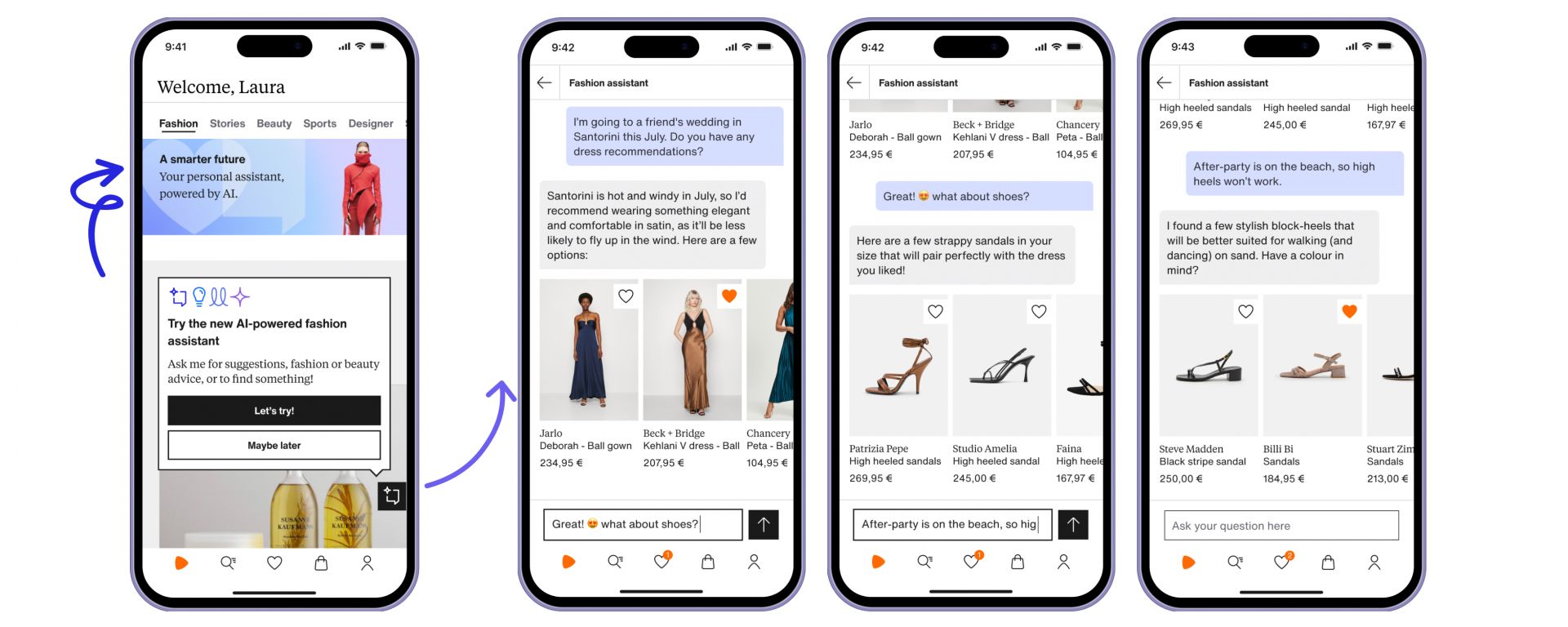
Zalando's AI assistant aims to make searching for fashion more intuitive
Zalando's AI assistant aims to make searching for fashion more intuitive
“With the fashion assistant, customers can navigate through Zalando’s assortment using their own words or fashion terms, making the process more intuitive and natural,” says Tian Su, Zalando VP, personalisation and recommendation. “For example, if a customer asks 'What should I wear for a wedding in Santorini in July?' Zalando's fashion assistant is able to understand that this is a formal event, what the weather is in Santorini in July, and therefore, provide a written explanation with recommendations for clothing based on that input.”
Zalando is not the only retailer using generative AI – in October 2023, Mango launched a conversational generative AI platform called Lisa, designed for internal use. It will be used to aid staff with a range of tasks, from trend analysis to supporting customer service.
Better data
The Very Group is another retailer often ahead of the curve when it comes to technology investment, and the business has been readying its data to ensure it is in a position to take advantage of AI and its potential.
In its 2022 annual report, it reported investing in data capabilities “building new analysis tools to create a single trusted source of information containing over 120 customer variables across 4.4 million active customer accounts”.
The work, it says, gives the retailer a rich dataset that offers deep understanding of each customer’s shopping behaviour. “The more we understand, the more relevant our product assortment and the more we can bring our customers’ shopping experiences to life. That means bespoke browsing and marketing experiences, including timely offers, recommendations and promotions.”
Justin Honaman, head of worldwide consumer products and retail at AWS, says working on data is wise, with the growth of AI meaning that – even if retailers aren’t exactly sure how things might pan out – good quality data will be critical to ensure a business can cope with future iterations of the technology. He says: “The shiny object is generative AI but you need data to run the models. That’s an interesting realisation for those who haven’t invested much in data and it's accelerating investments in new data platforms.”
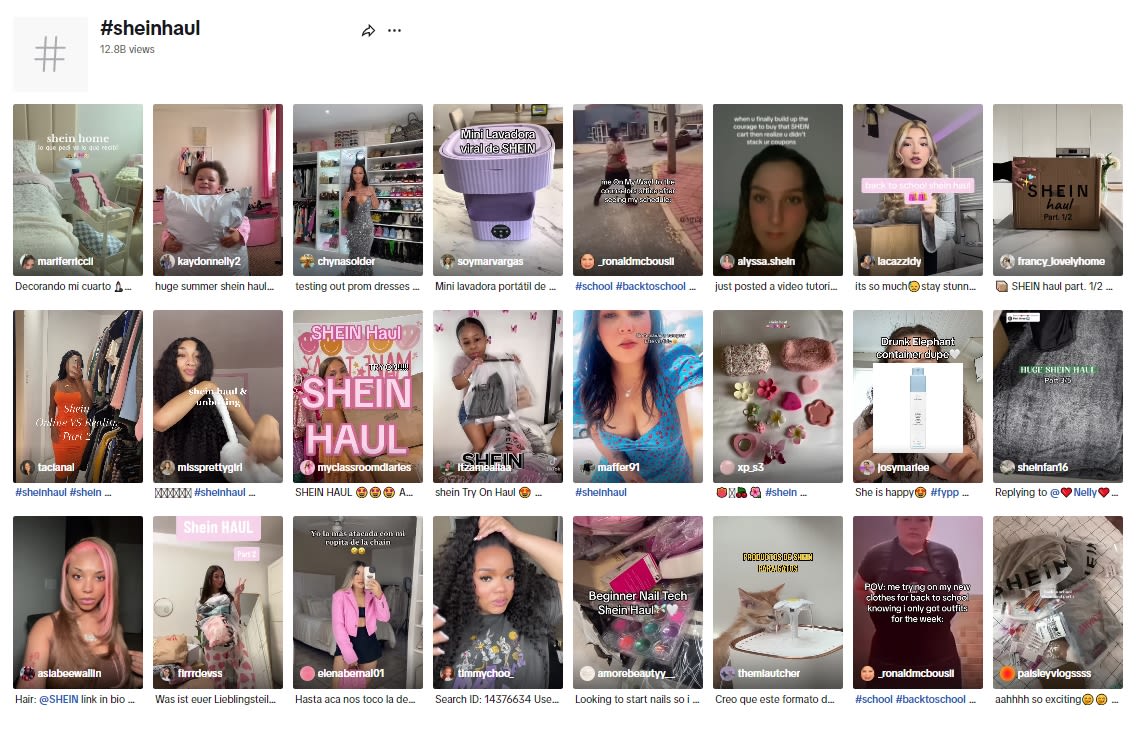
Shein uses data from social media mentions and web searches to identify fashion trends
Shein uses data from social media mentions and web searches to identify fashion trends

Digital passports provide information on materials, suppliers, packaging and more
Digital passports provide information on materials, suppliers, packaging and more
Improved forecasting
It’s worth the effort. Once a business’ data is in a good place, the sky is the limit. As Vlad Jiman, director of data at N Brown, says: “At its core, AI excels in analysing vast quantities of data with extreme speed. This capability is pivotal for retailers, given rapidly changing consumer preferences and market dynamics.”
He says data from customer reviews, sales and even social media will increasingly mean AI will unearth patterns, insights and trends that were previously not visible. “This [will enable retailers] to forecast demand more accurately, optimise inventory levels and ensure the right product mix, thereby maximising profitability and minimising waste.”
Honaman at AWS agrees these areas are set to vastly improve. While traditional analytics have enabled some form of forecasting for years, generative AI will turbo-charge retailers’ ability to predict the future.
Chinese fast-fashion retailer Shein already uses unstructured data from social media mentions and web searches to identify fashion trends and predict the most popular colours, fabrics and styles. Honaman says generative AI will help retailers get better at forecasting and enable increasing granularity. “What products are best for which store location? And which store for which product based on customer behaviour? That can be powered by AI and machine learning,” he says.
Predicting demand more accurately will hopefully reduce waste – one of fashion’s biggest problems for both the environment and the bottom line.
Retail Week’s Byfield-Green says AI offers countless other ways of improving fashion’s environmental footprint, mainly via better tracking and more efficient operations.
But she adds: “A big watch-out is the energy required to increase computing power for this, so it’s a bit of a dichotomy for businesses right now.”
One other area of potential she points to is transparency, which young fashion brand Nobody’s Child has recently tackled with ‘digital product passports’ – QR codes on product labels that offer information on raw materials, suppliers, logistics, packaging and more. “Over time, this is likely to be brought in as EU legislation and it will help with traceability and for retailers to track their journey to net zero,” says Byfield-Green.
Customer experience
Other forms of data will be used to improve customer experience, basket size and conversion rates. Brendan Forrester, VP and principal analyst at Forrester, points to US electronics retailer Newegg, which is using generative AI to summarise product reviews on its site with the goal of saving customers time in trawling through hundreds of them.
Beneath each product image, the site shows ‘Review Bytes’ that highlight keywords that appear frequently in reviews. The retailer reported that 20% of its customers read reviews and they spend 44% more than those who don’t.

'Review Bytes' on Newegg are created by AI summarising customer reviews
'Review Bytes' on Newegg are created by AI summarising customer reviews
Witcher says generative AI’s ability to analyse this kind of unstructured data will also change the way customer surveys, feedback and market research are tackled. Instead of using tick boxes, which don’t always offer huge insight, customers can be asked to write more expansively about why they do or don’t like something. AI can then be used to analyse and summarise their feedback.
Creative partner
Jiman at N Brown says the next step for AI, beyond analysis and insight, is becoming a collaborator. “More recently, AI has moved on from being just a passive analytical tool; it is also becoming a creative partner. Through techniques like generative design, AI can propose novel product designs, marketing assets, or ways to answer customer queries. These proposals can spark innovation, ensuring retailers stay ahead of the curve.”
Honaman at AWS mentions a footwear client whose new product development team is using AI models – with parameters and input provided by the brand – to come up with ideas for new shoe designs. “The models are then generating images that can be tweaked and refined until you get to something that can be launched. For certain products, the timeline for creating new products will be rapidly accelerated.”
Spanish retailer Mango is another brand whose 500-strong design team, based in Barcelona, uses AI to identify emerging trends and create unique patterns and prints. Its Inspire generative AI platform of images has been used to co-create more than 20 garments since it was launched.
It’s not just design ideas where AI – as well as other technologies such as 3D avatars – can help. Jiman’s colleague at N Brown, Sarah Ewens-Smythe, group head of responsible sourcing, sustainability and fit, points to technology’s role in improving the fit of clothing.
“We take over 200 body measurements in our body scanning machine and analyse the effects of ageing, size growth and movement on shape and posture, to establish a customer-centric fit. Using the data from the body scans, we’ve created unique 3D avatars to simulate the variety of fabrics, customer body shapes and sizes, enabling 3D design and fit of the perfect style.” She says the work is improving the quality and fit of items, and helping the business get to know its customers better.
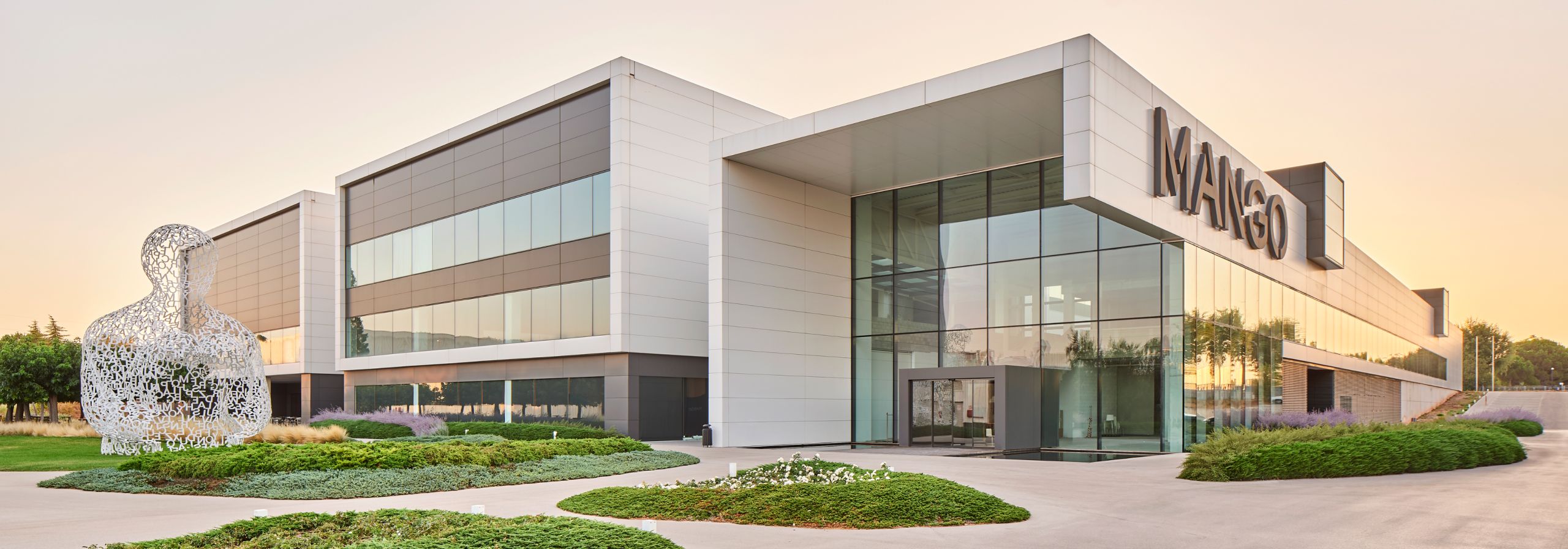
Deeper relationships
Getting to know the customer better is a sentiment echoed by Zalando. “Offering a personalized experience is key to deepening customer relationships, connecting with them and supporting them,” Su says. “Therefore we clearly see that this is one of the key areas where AI is playing, and will continue to play, a fundamental role. It can help us ‘get to know’ our customers better and therefore, suggest items, styles and also help them find inspiration.”
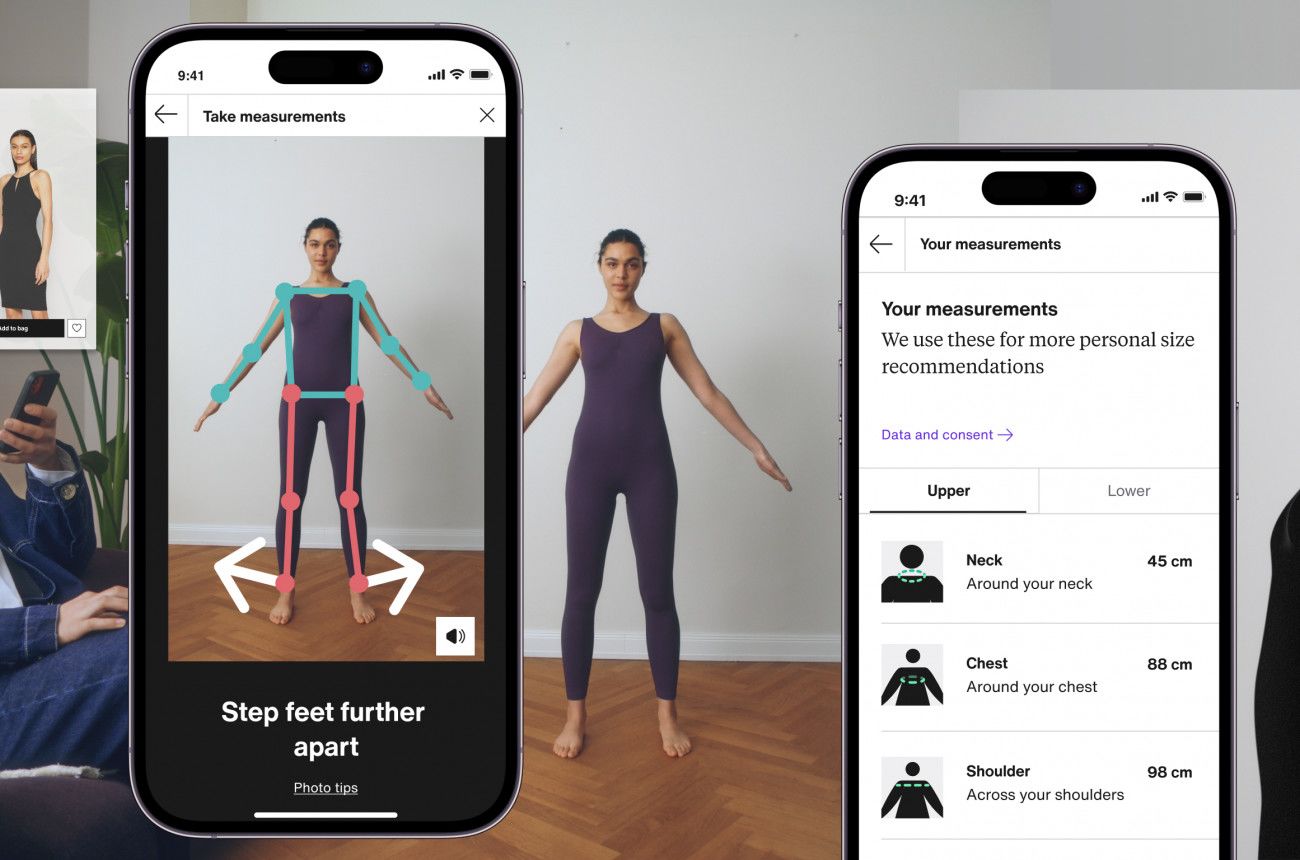
AI can help customers feel more confident in their online fashion purchases
AI can help customers feel more confident in their online fashion purchases
It doesn’t end there, however – internal data and features are also being improved. “Internally, this effort drove the enhancement of the available product metadata, backend features such as spell correction and many other technologies, which broadly enhanced customer experiences at Zalando,” Su says.
This deeper, more personalised relationship with customers will be a key feature of an AI-enabled future for the fashion retail sector. Especially when applied to online retail, Witcher says the technology will help retailers solve problems that have plagued them for years.
He points to shoppers flocking back to stores post-pandemic, saying: “There are things we value about the store and one of those is being able to talk about something, or touch and feel something. What these technologies allow now is removal of that problem of ‘I can’t buy that online, because I don’t feel confident in that purchase.’”
Fluid conversation
Being able to ask context-heavy questions – such as Zalando’s Santorini wedding outfit question – and get helpful responses could be transformational for an industry where consumers are so awash with choice that it can take time to find exactly what they want.
Witcher says this applies to stores, too. “If a customer asks, ‘what are your store opening hours’, we can do that. But what we couldn’t do is, ‘which one of your stores near me has a salesperson who’s been working there for 20 years?’ Adding some colour and context. The dynamic, fluid nature of that conversation couldn’t exist before and now it can.” In an industry where purchases can be about anything from comfort to personal self-expression, this is important.
Fashion’s shift to becoming more fluidly conversational, with a deep knowledge of customers, faster product development and accurate forecasting, will characterise the next few years.
As Honaman says, it’s difficult to be certain where things are heading. “I can show you a bunch of potential use cases and we could do this again six months and I promise you, they will be different. It’s just fascinating how fast it’s moving.”
The one thing retailers cannot afford to do, he says, is ignore it. “This is something that is unique. Just please have someone keeping an eye on it, somebody engaged. Because it’s going to be significant.”
Three more technologies changing fashion
- RFID tagging: RFID continues to spread across the fashion industry, with Amazon using it to enhance its Just Walk Out technology for clothing. RFID tags are attached to each item, allowing real-time stock monitoring. Just Walk Out technology requires shoppers to enter the store by scanning their credit or debit card on entry, or by identifying themselves using the Amazon app. They can then pick up items and leave without waiting to pay at a till. Other fashion retailers including Zara, Decathlon and Uniqlo are installing self-checkouts that can instantly read RFID tags and calculate the total amount without the need for scanning.
- Virtual try-on: As Retail Week’s Lisa Byfield-Green says: “Online avatars are a game-changer for fashion.” Fit remains a problem for online fashion retailers – it is still difficult for consumers to be confident of how the item will feel on them. John Lewis is one retailer working to tackle this, partnering with Zyler to pilot virtual try-on for its rental platform. Mango, meanwhile, has invested in Union Avatars, a digital identity and virtual avatar creation start-up. It will explore different pilot trials to create hyper-realistic avatars for use in different points of its value chain.
- Augmented reality: Nike has long led the way with technology-driven in-store experiences. In April 2023, Snapchat owner Snap announced it would be launching augmented reality mirrors that allow shoppers in Nike stores to see how clothes look on them without physically trying them on. The mirrors are being tested in some US Nike stores in 2023.
Partner viewpoint


Alice Chidgey, Customer Success Manager, Bloomreach Engagement UK
There’s no doubt — the AI in fashion retail boom is officially here. Generative AI has paved the way for businesses all over the world to personalise customer experiences at scale without having to overwork their commerce-driving teams.
How, specifically? By using conversational AI to power chatbots that automatically enhance customer experiences. Like Zalando’s fashion assistant, these chatbots open up a whole new world of possibilities for ecommerce companies looking to personalise customer experiences and enhance their conversational commerce strategies.
And it’s important to note, these aren’t the AI-powered chatbots that we grew up stuck in awkward conversations with. Thanks to the massive leap made in the last 18 months with large language models, those days are over. These chatbots use natural language processing techniques and can now hold a conversation just as well (or maybe even better) than two humans can.
But your AI is only as good as the data you power it with, which makes compliantly collecting customer data and pairing that with your product data even more important as we prepare for 2024. Training your AI will become as important as training your new employees. These chatbots will become an extension of your brand, able to answer open-ended questions 24/7/365, leaving your commerce-driving team free to work on more creative tasks.
The moral of the story? Don’t get left behind next year without access to AI-powered use cases or conversational commerce capabilities. Ecommerce companies all over the world are using AI to enhance customer experiences online and to understand their customers on a deeper level. If you aren’t using AI to analyse your customers’ behavior and in turn optimise the shopping experience, it’s time to start.

What does a successful fashion strategy look like?
The Fashion Forward: Forecasting the sector’s future model content series will provide the answers. Upcoming content includes:
- The products consumers will be buying three years from now
- Date to be confirmed – Virtual panel discussion, Fashion Forward: Forecasting the sector’s future model
This report was produced by:

James Knowles
Head of content innovation, Retail Week

Louise Prance
Report writer

Hanna Hua
Data analyst, Retail Week

Alban Bizet
Senior designer, RWRC



